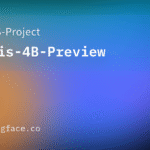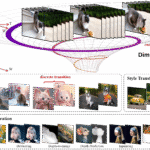
🌟 From Noise to Clarity: Enhancing Generative Models with Continuous-Time Flow Maps

🚀 Introduction
Generative modeling has witnessed significant advancements with the emergence of diffusion and flow-based models, which have set new benchmarks in generating high-quality images. However, these models often require numerous sampling steps to produce satisfactory results, leading to increased computational costs and slower inference times. On the other hand, consistency models aim to distill these complex models into efficient one-step generators, but their performance tends to degrade as the number of sampling steps increases.
In response to these challenges, the paper “Align Your Flow: Scaling Continuous-Time Flow Map Distillation” introduces a novel approach that bridges the gap between diffusion-based, flow-based, and consistency models. The core innovation lies in the concept of flow maps, which connect any two noise levels in a single step, maintaining effectiveness across all step counts. This generalization allows for efficient and high-quality generation, regardless of the number of sampling steps.
The authors propose two new continuous-time objectives for training flow maps: Eulerian Map Distillation (AYF-EMD) and Lagrangian Map Distillation (AYF-LMD). These objectives unify existing consistency and flow matching objectives, providing a robust framework for training flow maps. Additionally, novel training techniques, including autoguidance and adversarial finetuning, are introduced to enhance the performance of the distilled models.
Extensive evaluations on challenging image generation benchmarks, such as ImageNet 64×64 and 512×512, demonstrate that the proposed flow map models, termed Align Your Flow (AYF), achieve state-of-the-art few-step generation performance using small and efficient neural networks. Furthermore, the approach is extended to text-to-image generation, where AYF models outperform existing non-adversarially trained few-step samplers in text-conditioned synthesis.
In this blog post, we delve into the key concepts and contributions of the Align Your Flow framework, exploring its potential to revolutionize generative modeling by providing a scalable and efficient solution for high-quality image and text-to-image generation.
🧠 Overview
Align Your Flow (AYF) introduces a scalable framework that distills high-performing generative diffusion or flow-based models into efficient few-step samplers by learning continuous-time flow maps. This approach unifies the paradigms of flow-based, diffusion-based, and consistency-based generative modeling, offering a robust solution for high-resolution and text-conditioned image synthesis. The central contribution is a distillation strategy that enables models to produce high-fidelity samples in very few, or even a single, integration step—while maintaining robustness across a wide range of step counts. emergentmind.com
🔍 Comparison with Other Models
AYF flow maps outperform existing models in several key aspects:
- Sampling Efficiency: Unlike consistency models, which degrade in performance when sampled with more than two steps, AYF flow maps maintain high quality across a wide range of step counts. emergentmind.com
- Model Size and Quality: On ImageNet 64×64 and 512×512, AYF achieves state-of-the-art FID and Recall among all non-adversarial, few-step samplers. Small AYF models outperform much larger prior models at low computational cost. emergentmind.com
- Sampling Flexibility: Multi-step or deterministic sampling settings do not degrade quality, in contrast to consistency-based approaches. emergentmind.com
🏗️ Architecture of Align Your Flow (AYF)
The Align Your Flow (AYF) framework introduces a novel architecture that bridges the gap between diffusion-based, flow-based, and consistency-based generative models. At its core, AYF employs continuous-time flow maps to facilitate efficient and high-quality image generation across various sampling steps.
🔄 Continuous-Time Flow Maps
Flow maps are parameterized functions that deterministically transport a point from one noise level to another, including the data distribution at the target noise level. This approach generalizes both consistency models and flow matching by connecting any two noise levels in a single step, maintaining effectiveness across all step counts.
🧭 Training Objectives
AYF introduces two continuous-time objectives for training flow maps:
- Eulerian Map Distillation (AYF-EMD): This objective enforces that the flow map output at the target time remains invariant as the input is infinitesimally transported along the probability flow ODE towards the target. It generalizes both the flow matching and consistency model losses.
- Lagrangian Map Distillation (AYF-LMD): This objective considers the trajectory of a fixed point as a function of time, enforcing consistency between the map trajectory and the probability flow ODE vector field. It generalizes existing consistency and flow matching objectives.
⚙️ Training Techniques
To enhance the stability and performance of the flow maps, AYF incorporates several novel training techniques:
- Autoguidance: Utilizes a weaker, low-quality teacher model to provide additional guidance during distillation, focusing training on regions where the baseline teacher is weak.
- Adversarial Finetuning: Applies brief, post-hoc adversarial finetuning to sharpen samples, particularly at one-step sampling, without sacrificing diversity.
- Parameterization and Tangent Normalization: Stabilizes optimization dynamics by managing rapid variations arising from continuous-time formulations.
- Flexible Time Scheduling: Ensures the flow map is reliable for both short and long-range transitions by sampling pairs across a diverse range.
- Stop-Gradient Targeting: Prevents instability by avoiding backpropagation through Jacobian-vector products during training.
🖼️ Visual Representation
While a direct diagram of the AYF architecture isn’t provided in the available resources, the conceptual framework can be visualized as follows:
- Input Noise Level (s): The starting point in the noise space.
- Flow Map: A function that maps the input noise level to the target noise level.
- Target Noise Level (t): The desired endpoint in the noise space, which can correspond to the data distribution.
- Output Sample: The generated sample after applying the flow map from s to t.
This process is designed to be effective across various step counts, from a single step to multiple steps, ensuring high-quality generation.
🛠️ Open Source and System Details
The Align Your Flow framework is built upon the Verl codebase, facilitating reproducibility and extensibility. The training and evaluation pipeline is designed to be modular, allowing researchers to experiment with different configurations and datasets. The authors have open-sourced their complete dataset, code, and training details to foster progress in scaling RL on advanced reasoning models.
⚙️ Setting Up the Environment
To set up the environment for training and evaluating AYF models:
- Clone the Repository: Access the official codebase from the Verl GitHub repository.
- Install Dependencies: Ensure that all required libraries and frameworks are installed. This typically includes deep learning libraries such as PyTorch and other dependencies specified in the project’s documentation.
- Prepare the Dataset: Download and preprocess the dataset as per the instructions provided in the repository.
- Configure Training Parameters: Adjust the configuration files to set parameters such as learning rate, batch size, and number of training steps according to your computational resources.
- Initiate Training: Run the training scripts to begin the model training process.
- Evaluate the Model: After training, use the evaluation scripts to assess the model’s performance on benchmark datasets.
For detailed instructions and troubleshooting, refer to the official documentation.
🔮 Future Scope, Conclusion, and References
🔮 Future Scope
The Align Your Flow framework opens avenues for several future research directions:
- Extended Applications: Exploring the applicability of AYF models in other domains such as audio synthesis and video generation.
- Enhanced Training Techniques: Developing advanced training strategies to further improve the efficiency and quality of generated samples.
- Integration with Other Models: Investigating the integration of AYF models with other generative models to leverage their complementary strengths.
✅ Conclusion
Align Your Flow represents a significant advancement in generative modeling by providing a scalable and efficient solution for high-quality image and text-to-image generation. By unifying existing methodologies and introducing novel training techniques, AYF models achieve state-of-the-art performance across various benchmarks.
📚 References
- Sabour, A., Fidler, S., & Kreis, K. (2025). Align Your Flow: Scaling Continuous-Time Flow Map Distillation. arXiv. arxiv.org
- EmergentMind. (2025). Align Your Flow (AYF). emergentmind.com
- arXiv. (2017). Continuous-Time Flows for Efficient Inference and Density Estimation. arxiv.org+1transferlab.ai+1
- arXiv. (2024). Flow Map Matching. arxiv.org

